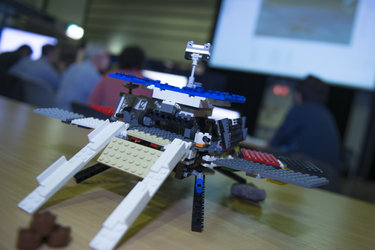Accept all cookies Accept only essential cookies See our Cookie Notice

About ESA
The European Space Agency (ESA) is Europe’s gateway to space. Its mission is to shape the development of Europe’s space capability and ensure that investment in space continues to deliver benefits to the citizens of Europe and the world.
Highlights
ESA - United space in Europe
This is ESA ESA facts Member States & Cooperating States Funding Director General Top management For Member State Delegations European vision European Space Policy ESA & EU Space Councils Responsibility & Sustainability Annual Report Calendar of meetings Corporate newsEstablishments & sites
ESA Headquarters ESA ESTEC ESA ESOC ESA ESRIN ESA EAC ESA ESAC Europe's Spaceport ESA ESEC ESA ECSAT Brussels Office Washington OfficeWorking with ESA
Business with ESA ESA Commercialisation Gateway Law at ESA Careers Cyber resilience at ESA IT at ESA Newsroom Partnerships Merchandising Licence Education Open Space Innovation Platform Integrity and Reporting Administrative Tribunal Health and SafetyMore about ESA
History ESA Historical Archives Exhibitions Publications Art & Culture ESA Merchandise Kids Diversity ESA Brand CentreLatest
Space in Member States
Find out more about space activities in our 23 Member States, and understand how ESA works together with their national agencies, institutions and organisations.
Science & Exploration
Exploring our Solar System and unlocking the secrets of the Universe
Go to topicAstronauts
Missions
Juice Euclid Webb Solar Orbiter BepiColombo Gaia ExoMars Cheops Exoplanet missions More missionsActivities
International Space Station Orion service module Gateway Concordia Caves & Pangaea BenefitsLatest
Space Safety
Protecting life and infrastructure on Earth and in orbit
Go to topicAsteroids
Asteroids and Planetary Defence Asteroid danger explained Flyeye telescope: asteroid detection Hera mission: asteroid deflection Near-Earth Object Coordination CentreSpace junk
About space debris Space debris by the numbers Space Environment Report In space refuelling, refurbishing and removingSafety from space
Clean Space ecodesign Zero Debris Technologies Space for Earth Supporting Sustainable DevelopmentLatest
Applications
Using space to benefit citizens and meet future challenges on Earth
Go to topicObserving the Earth
Observing the Earth Future EO Copernicus Meteorology Space for our climate Satellite missionsCommercialisation
ESA Commercialisation Gateway Open Space Innovation Platform Business Incubation ESA Space SolutionsLatest
Enabling & Support
Making space accessible and developing the technologies for the future
Go to topicBuilding missions
Space Engineering and Technology Test centre Laboratories Concurrent Design Facility Preparing for the future Shaping the Future Discovery and Preparation Advanced Concepts TeamSpace transportation
Space Transportation Ariane Vega Space Rider Future space transportation Boost! Europe's Spaceport Launches from Europe's Spaceport from 2012Latest
Time-lapse rover testing
Thank you for liking
You have already liked this page, you can only like it once!
A sped-up view of ESA-CNES rover ‘egress’ testing that took place in one of Europe’s largest mock-Mars landscapes.
Every journey begins with a single step – or in this case a downward trundle.
The egress of Europe’s ExoMars 2018 rover off its lander will be the second most stressful moment of the mission after Mars landing.
So to build up experience in the problem, a half-scale rover on a mock-up lander was placed in the outdoor 80 x 50 m ‘Mars Yard’ of French space agency CNES for a two-day test campaign on 28-29 October.
It was controlled remotely by a team based at ESA’s ESTEC technical centre, a thousand kilometres away in the Netherlands.
They were given no idea where in the sprawling Mars Yard the rover was located for each test scenario – the only information they could access came from cameras and sensors in the rover and lander.
Adding to the difficulty, real-time remote control of the rover was out – the sheer distance to Mars will make it impractical reality. Instead they could receive telemetry at regular intervals then send back a to-do list of telecommands.
For the purposes of testing these communication passes came once every hour – in reality they would occur once or twice a day.
The team on the ESTEC side came from ESA’s Automation and Robotics section and ExoMars project as well as from industrial partners Trasys Space Belgium, Thales Alenia Space Italy and Altec Italy. In addition the testing was also tracked from ESA’s ESOC control centre in Darmstadt, Germany.
For each egress they worked to build up a detailed virtual model of the rover’s surroundings, as well as stitching together a panorama from the various camera views.
The lander has two sets of ramps down to the surface, so the team had to decide which way down was safer. This video shows a rapid time-lapse version of the whole process – in reality the rover took more than two minutes to egress off the lander each time.
A total of five egress tests were performed: four ended in success and one in failure – the rover descended down at too steep an angle and began to topple off. In real life the mission would have ended there, but in this case it was safely caught by helping hands.
The incident demonstrated the importance of such simulations, which also allowed the practical testing of various software tools developed over years of research.
The testing was organised by ESA’s Planetary Robotics Laboratory in cooperation with CNES and ESOC. The results will be used will be valuable inputs in the design of the actual ExoMars mission.
-
CREDIT
ESA -
LICENCE
ESA Standard Licence
-
Music Clip
-
-
-
-
-














 Germany
Germany
 Austria
Austria
 Belgium
Belgium
 Denmark
Denmark
 Spain
Spain
 Estonia
Estonia
 Finland
Finland
 France
France
 Greece
Greece
 Hungary
Hungary
 Ireland
Ireland
 Italy
Italy
 Luxembourg
Luxembourg
 Norway
Norway
 The Netherlands
The Netherlands
 Poland
Poland
 Portugal
Portugal
 Czechia
Czechia
 Romania
Romania
 United Kingdom
United Kingdom
 Slovenia
Slovenia
 Sweden
Sweden
 Switzerland
Switzerland






























